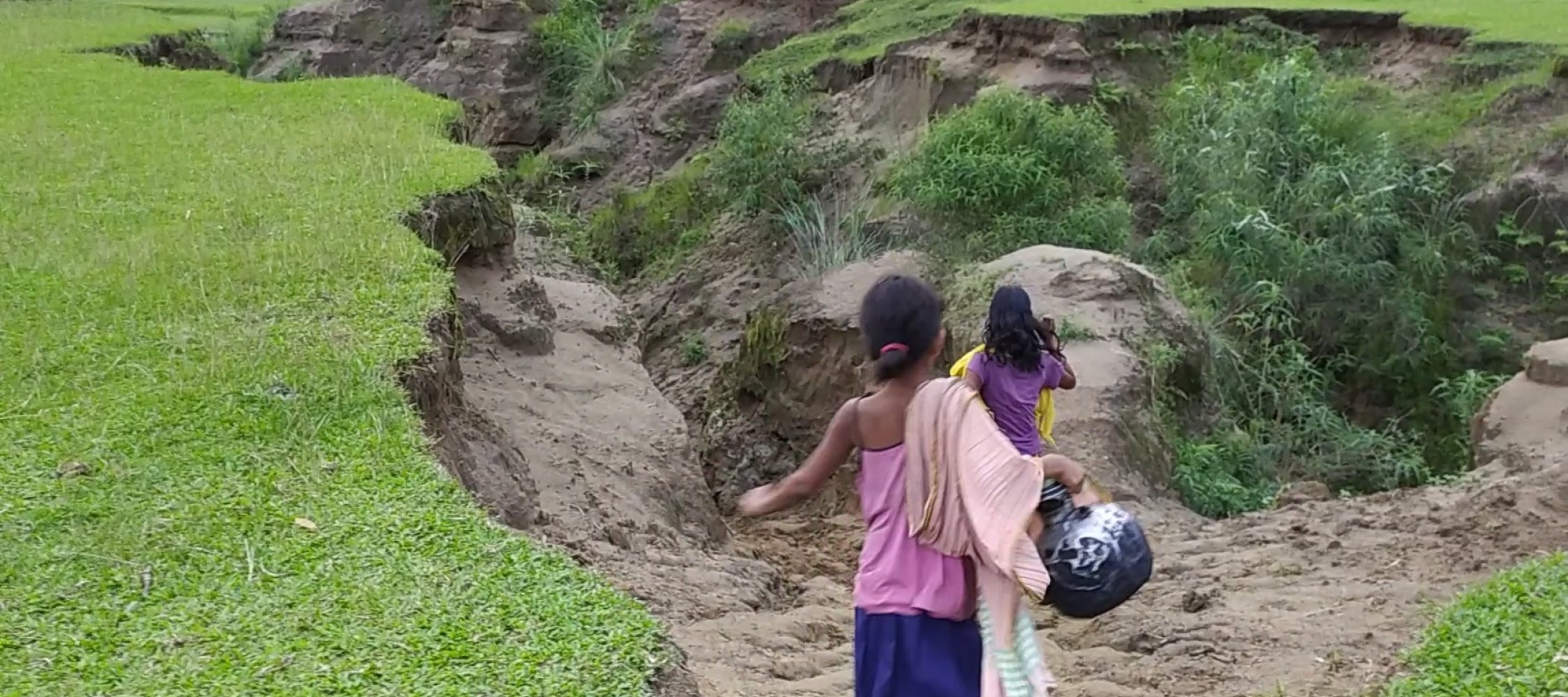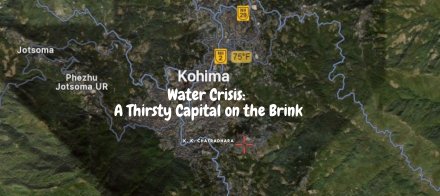 |
As the dawn breaks, five-year-old Moumita Sutradhar of Pachani Camp should be preparing her lessons or readying to go to school, like most children of any town dwellers do. Instead, she has to take a 2 km brisk walk to fetch drinking water for the family before she heads for the school. She is not alone, though; almost all her friends in the village go through the same routine – not once but twice or thrice, depending on the family needs. Not that the children are forced to sweat over this, whoever is free in the family – generally, women and sometimes men – does that household chores.
Welcome to the Pachani Camp, where water is the most sought-after resource!
Pachani Camp, comprising a few ‘forest’ villages located on the foothills of the Assam-Arunachal Pradesh boundary, has been reeling under acute problems of water scarcity ever since people began to settle down there in the 1950s. This forest patch is claimed both by Arunachal Pradesh and Assam, though they observe the status quo to maintain peace and tranquility in the area. The camp falls under the Mingmang gaon panchayat of Bordoloni block in the Dhemaji district of Assam. The site also falls under the Mingmang constituency of the Mising Autonomous Council (MAC), which is represented by Paramananda Chayengiya, the chief executive member (CEM) of the council. During a conversation with the people of these villages, particularly Dirpaisantipur, Dharmapur, and Kailashpur, they raised the perennial water security problem and the day-to-day struggle of collecting water for household purposes, especially safe drinking water.
It is quite unusual that people settled down in an area where water was a major problem and for such a long time! The sandy dry land here was not suitable for cultivation, and the area was a part of the forest reserve. At the beginning of their settlement, the people tried to plant banana trees in their homesteads. However, they were not free from trouble; they were treated as encroachers. So, now and then, the forest personnel would come with elephants and pull down their huts and orchards. Despite this hardship and uncertainty, hundreds of families had settled there and set up several villages.
Most of the families who came to the area were displaced from the undivided Lakhimpur district’s flood-affected regions in the wake of the Great Earthquake of 1950. It changed the geomorphology of the Brahmaputra river basin that unleashed frequent floods and erosion of land. Experts say the intensity and frequency of floods increased due to the elevation of the riverbeds caused by a higher silt deposition level. Local people said floods were more hazardous than water scarcity. However, several families who were displaced by flood and erosion and had chosen to settle at the Pachani Camp over the years, left the place too after living just a couple of years to move to other sites only because of water scarcity. On inquiry, the villagers revealed that there were indeed several migrant families belonging to Mising, Ahom, Chutia, Konch Rajbongshi, Bodo Santhal communities, who were displaced by floods and found shelter in this place. They eventually got stuck there.
The Pachani camp area, which lies on a higher ground, is drained by two hill streams flowing down the foothills from Arunachal Pradesh by its east and west flanks like two arms. The one, which flows down southwards from the eastside of the Pachani Camp, is Naharjan. This tiny and shallow stream joins another stream, Borola and runs further east. The other, known as Chauldhuwa nallah, also originates from the neighbouring hills, but rolls down by the west side; both eventually outfall into the river Subansiri. These two hill streams are the only water sources for about a thousand families settled in the area. The streams – east or west on either side – lie 3 km to 5 km away from these villages.
Dirpaisantipur is the nearest village to the Chauldhuwa Nallah, which is about 500 metres to 2 km away from the nearest ghat (water collection point), while the Dharmapur village is situated about 2-3 km away; Kailashpur is the farthest from the ghat. Therefore, most of the village inhabitants partly go to Naharjan, which is nearer than the Chauldhuwa Nallah. Other than the monsoon months (June, July, and August), Naharjan remains almost dry, and even if a bit of water is found in some stretches, it is too filthy to be of any use. Chauldhuwa Nallah, on the other hand, retains at least ankle-deep water and flows throughout the year but swells up in monsoon with heavy precipitation in the adjacent hills of Arunachal Pradesh.
Interestingly, villagers do not directly use the flowing surface water for drinking purposes. They choose a swampy place by the riverside and dig a round pit up to a foot or more, and then create a sand bund around the dug-hole so that no surface water of the stream enters it. Soon after the pit is dug, clear water starts to well up from its bottom, which is collected for drinking. Everyone uses this technique for collecting drinking water from the stream. Of course, this does not work during the monsoon season.
“Getting to the river itself is a hazard as one has to climb down the steep slope of the river bank,” said Munu Boruah. “Climbing up the slope with a heavy water-filled vessel on head or waist is even more difficult for children and women.” Many young women complained of pain in their head, neck, back, and waist, but said that they had no choice but to continue to carry on their domestic work. They generally ignore the pain till it becomes chronic and unbearable. Most of the women suffer in silence from various drudgery-induced ailments.
Speaking of the difficulties, villagers shared anecdotes of some embarrassing moments and discomfort associated with the daily hunt for water. One story goes like this: A newly married woman on the day of her arrival in the village was shocked to learn that there was no provision for water in the house; everyone has to walk a kilometre or more to gather water from streams. One can imagine how miserable the young bride may have felt and how embarrassed her in-laws may have been. Women – young or old in the village – say they feel particularly uncomfortable when they are compelled to take bath in the stream under public gaze or sometimes exposed to an undesirable situation; it violates their dignity and privacy. Eventually, they all get used to it or ignore all that, said Sujita Chautal, a young woman who also faced such sly comments. Villagers jokingly said, young women who knew of the acute water crisis in the Pachani camp area even avoided marrying men from these villages.
There are also stories about guests and relatives visiting their friends’ houses and fleeing the place soon after the visitors faced the reality of water scarcity. In most cases, villagers would say, unleashing a burst of laughter among them, the guests leave the village in a day or two under some pretext of sudden urgent work or emergency. Dipali Boruah, an India Post employee at Gogamukh, narrated a similar story of her cousin who had visited a relative in the Pachani camp years ago. “She later told me of the terrible water situation in the village, and she was so embarrassed that she would never stay there again, even for a day,” Boruah said.
Villagers said that many had tried to install tube wells or dig ring wells, but all those efforts turned out to be futile as water levels found to be as low as 80 feet to 100 feet below the ground in the dry months; even in the rainy months, the water level remained at around 60-70 feet down. Haru Das, who lives close to the Chauldhuwa stream, said: “We tried to install tube wells, but water was not found even at 80 feet beneath the ground. We abandoned that plan and turned to these streams, as there was no other source of water found anywhere in the area.” A few individuals took financial risks and installed tube wells, but these became dysfunctional once the monsoon was over and the water level went much below the reach of the installed pipe by mid-September, he said.
The Mising Autonomous Council (MAC) and the Public Health Engineering (PHE) Department also attempted several times to dig ring wells and tube wells in the area, but all these efforts were unsuccessful.
A few years back, a tragic incident was reported in the local media. A young labourer, Jiten Pegu alias Nampho, died of suffocation while digging a well at Dharmapur village. Villagers recall, on that fateful day at around 1:30 in the afternoon, Nampho went down the 25-feet deep well to explore further but suddenly collapsed there. His co-workers – Prasanta Phukan and Bijay Kalita – getting no response or sound from below, came to the edge of the well, and when they looked down, they saw Nampho lying in the pit. They both immediately rushed down to rescue him, but they also soon fell unconscious. The villagers called out for help, and after a while, with the combined efforts of the Assam Police Battalion (APBn) and the Central Industrial Security Force (CISF) personnel, they were pulled out of the well. But unfortunately, by then, Nampho has already breathed his last, and two of his friends, still unconscious, were sent to the Gogamukh community health centre.
The NHPC Ltd., under its corporate social responsibility (CSR) programme, launched a water supply scheme called ‘Kalash’. They installed four 5,000-litre capacity water storage tanks in selected locations. Water is drawn from the ground to the tanks by using electric pumps. However, in the dry winter months, most of the time, the scheme remains non-functional, as the groundwater level sharply falls beyond the reach of the pump. Moreover, the supply of electricity is irregular in the area, affecting the water supply scheme. The Assam Power Distribution Corporation Limited (APDCL) is responsible for providing electricity to the site, but that is not reliable with frequent power cuts or low voltage. Although the Kalash scheme is poorly implemented, only a few households located near these water tanks get water; most of the villagers continue to suffer. Suchen Baruah, a resident of Dharmapur village, said that these water tanks were too small to cater to the water demand of the whole area. Moreover, he complained that the water had high iron content and so was not potable. As groundwater depletes in the off-monsoon seasons, the electric pumps cannot extract water; it works only in the monsoon, and that too, often remains defunct due to the low quality of the instruments.
Though the people of Pachani Camp do not buy water, they have to spare some money out of their meagre wages to buy some containers for storing water. Those who are relatively better off buy bicycles for their mobility and other purposes, including for carrying water. Three micro-finance institutions, namely – Bandhan, Aroohan, and Annapurna – which operate in the area, offer loans to the villagers, mostly to women. Though women SHGs take loans mainly for income-generating activities or meeting any family emergency, they sometimes spend part of their loan buying water vessels and kitchen appliances.
Water shortage in the villages also created other problems of poor hygiene and sanitation. Under the Swachh Bharat Abhiyan, a few sanitary latrines were constructed, but people didn’t like to use them due to lack of water; instead of using the toilet, many go for open defecation. Human waste finds its way to streams, rivers, and other water bodies, exposing people, especially children, to water-borne diseases and other ailments. Open defecation is a serious threat to public health and the environment.
Geolocation is 27.534545180461187, 94.29580980873675


